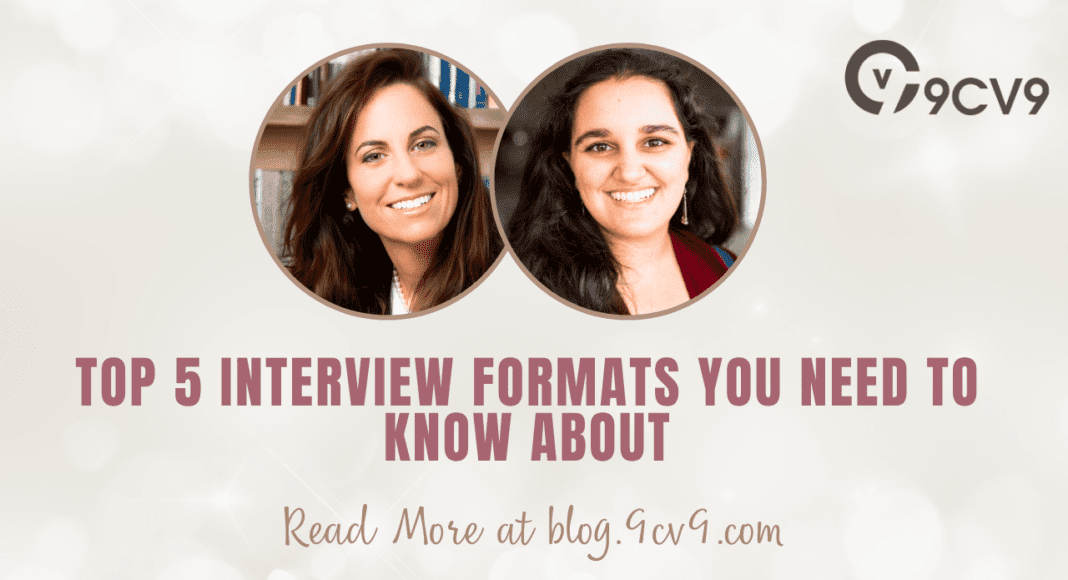Key Takeaways
- Familiarize yourself with various interview formats: Gain an understanding of traditional, behavioral, case study, panel, and video interviews to excel in different hiring scenarios.
- Tailor your approach: Each interview format requires unique strategies. Customize your responses to highlight relevant experiences, problem-solving skills, and cultural fit.
- Stay adaptable: With evolving technology and remote work trends, video interviews are becoming increasingly common. Adapt to virtual settings and showcase your professionalism and communication skills.
In today’s competitive job market, finding the right candidate is crucial for the success of any organization.
The hiring process plays a pivotal role in determining the suitability and potential of candidates for a particular role.
One essential aspect of this process is the interview format used to assess candidates’ skills, qualifications, and cultural fit within the company.
Gone are the days of relying solely on traditional, face-to-face interviews.
With advancements in technology and changes in hiring practices, various interview formats have emerged, each with its unique approach and benefits.
In this comprehensive guide, we will explore the top 5 interview formats you need to know about, empowering you to make informed decisions and optimize your hiring process.
- Traditional Interview Format: Let’s start with the traditional interview format, which has long been the cornerstone of the hiring process. This format typically involves a one-on-one conversation between the interviewer and the candidate. We will delve into the pros and cons of this format and provide valuable tips to ensure successful traditional interviews.
- Behavioral Interview Format: Next up is the behavioral interview format, gaining popularity for its ability to assess a candidate’s past behavior as an indicator of future performance. We will explore the key components and structure of a behavioral interview, along with a range of sample questions to help you gauge a candidate’s competencies and skills effectively.
- Case Study Interview Format: The case study interview format is widely used in industries where problem-solving and critical thinking skills are of utmost importance. This format presents candidates with real or hypothetical scenarios, allowing them to demonstrate their ability to analyze and solve complex problems. We will examine the advantages and limitations of case study interviews, along with practical tips and real-life examples to guide you through the process.
- Panel Interview Format: Panel interviews involve multiple interviewers assessing a candidate simultaneously. This format offers a comprehensive evaluation by gathering diverse perspectives and insights. We will discuss the benefits and challenges of panel interviews, share strategies for success, and explore ways to navigate different dynamics that may arise during panel interviews.
- Video Interview Format: In today’s digital age, video interviews have gained immense popularity, particularly for remote or global hiring processes. Video interviews allow recruiters to connect with candidates regardless of geographical boundaries, saving time and resources. We will examine the advantages and disadvantages of video interviews, offer best practices for conducting successful video interviews, and discuss the tools and technology available to facilitate seamless virtual interactions.
By familiarizing yourself with these top 5 interview formats, you can tailor your hiring process to suit specific job roles, company culture, and candidate preferences.
Each format brings its own strengths and limitations, so it’s essential to choose the right one for your organization’s needs.
This comprehensive guide will equip you with the knowledge and insights necessary to make informed decisions when it comes to selecting interview formats.
Whether you opt for the traditional format, behavioral interviews, case studies, panel interviews, or video interviews, understanding the nuances of each will enable you to conduct more effective and efficient hiring processes.
Stay tuned as we delve into each interview format, providing expert tips, real-world examples, and practical advice to help you optimize your interviews and make well-informed hiring decisions.
Let’s dive into the world of interview formats and revolutionize the way you find the perfect candidates for your organization.
Before we venture further into this article, we like to share who we are and what we do.
About 9cv9
9cv9 is a business tech startup based in Singapore and Vietnam, with a strong presence all over the world.
With over six years of startup and business experience, and being highly involved in connecting with thousands of companies and startups, the 9cv9 team has listed some important learning points in this overview of the guide of the top 5 interview formats you need to know about.
If your company needs recruitment and headhunting services to hire top-quality employees, you can use 9cv9 headhunting and recruitment services to hire top talents and candidates. Find out more here, or send over an email to [email protected].
Or just post 1 free job posting here at 9cv9 Hiring Portal in under 10 minutes.
Top 5 Interview Formats You Need to Know About
- Traditional Interview Format
- Behavioral Interview Format
- Case Study Interview Format
- Panel Interview Format
- Video Interview Format
1. Traditional Interview Format

The traditional interview format has long been a staple in the hiring process, providing a direct and personal interaction between the interviewer and the candidate.
In this format, the interviewer typically asks a series of questions to assess the candidate’s qualifications, experience, and cultural fit within the organization.
While this format may seem straightforward, it still holds valuable insights when conducted effectively.
Pros of the Traditional Interview Format:
- Familiarity and Comfort: The traditional interview format is widely known and understood by both candidates and interviewers, creating a sense of familiarity and comfort. Candidates are likely to feel more at ease when participating in a format they are familiar with, enabling them to showcase their abilities and personality more effectively.
- Personal Connection: Face-to-face interviews allow interviewers to establish a personal connection with candidates. Non-verbal cues, such as body language and facial expressions, can provide valuable insights into a candidate’s communication skills, confidence, and engagement level.
- Immediate Feedback and Clarification: In a traditional interview, both parties have the opportunity to provide immediate feedback and seek clarifications on any points discussed. This real-time interaction allows interviewers to gauge a candidate’s ability to articulate their thoughts, respond to challenges, and engage in meaningful conversations.
Example of a Traditional Interview Format:
Interviewer: “Tell me about a time when you faced a challenging situation at work and how you handled it.”
Candidate: “Certainly! In my previous role as a project manager, we encountered a major deadline conflict between two client projects. To address this challenge, I scheduled a team meeting to discuss the issue, identify potential solutions, and prioritize tasks. By leveraging effective communication and collaboration, we were able to rearrange the project timeline, allocate additional resources, and successfully deliver both projects on time.”
Cons of the Traditional Interview Format:
- Subjectivity and Bias: Traditional interviews may be susceptible to interviewer biases, as subjective judgments can influence the evaluation process. Unconscious biases based on factors such as appearance, accent, or personal preferences may inadvertently affect the interviewer’s perception of the candidate’s suitability for the role.
- Limited Scope: Traditional interviews often focus on assessing a candidate’s qualifications and past experiences but may have limitations in evaluating their future potential or specific job-related skills. Relying solely on traditional interviews may overlook crucial aspects such as problem-solving abilities, adaptability, or creativity.
- Incomplete Picture: Candidates may feel pressured or nervous during traditional interviews, potentially hindering their ability to present themselves authentically. Some candidates may perform poorly due to interview anxiety, even though they possess the required skills and qualifications.
Tips for Conducting Successful Traditional Interviews:
- Prepare Structured Questions: Develop a list of structured questions that align with the job requirements and competencies you are seeking. This helps ensure consistency across interviews and facilitates a fair evaluation process.
- Active Listening: Actively listen to the candidate’s responses and ask follow-up questions to gain a deeper understanding of their experiences and capabilities. Engage in active dialogue to create a comfortable environment for open communication.
- Use Behavioral Questions: Incorporate behavioral questions that require candidates to provide specific examples of past experiences and accomplishments. For instance, asking, “Tell me about a time when you had to resolve a conflict within your team” allows candidates to showcase their problem-solving and interpersonal skills.
- Include Job-related Scenarios: Present candidates with hypothetical job-related scenarios and ask them how they would approach and solve the problem. This can help assess their critical thinking, decision-making, and problem-solving abilities.
Example Scenario:
Interviewer: “Imagine you’re a manager overseeing a team project, and one of your team members consistently falls behind on their assigned tasks. How would you address this situation?”
Candidate: “In such a scenario, I would schedule a one-on-one meeting with the team member to understand the underlying reasons for their performance issues. I would provide constructive feedback, identify any challenges they may be facing, and offer support or additional resources if needed. Together, we would develop an action plan to address their performance concerns and set clear expectations moving forward.”
By following these tips, interviewers can maximize the effectiveness of traditional interviews and obtain valuable insights into a candidate’s qualifications, communication skills, and cultural fit within the organization.
Stay tuned for the next section, where we will explore the behavioral interview format, which offers a more structured approach to assessing a candidate’s past behavior as an indicator of future performance.
Also read, how to set up an interview as a recruiter.
2. Behavioral Interview Format

The behavioral interview format has gained significant popularity in recent years as a reliable method for assessing a candidate’s past behavior and using it as an indicator of their future performance.
This structured approach allows interviewers to delve deeper into a candidate’s experiences, competencies, and problem-solving abilities.
By asking specific behavioral questions, interviewers can gain valuable insights into how candidates have handled situations in the past, providing a more accurate assessment of their suitability for the role.
Key Components and Structure of a Behavioral Interview:
- Competency-Based Questions: Behavioral interviews focus on specific competencies or skills required for the role. Interviewers design questions that prompt candidates to provide real-life examples of their experiences, achievements, and challenges related to these competencies. These questions typically begin with phrases like “Tell me about a time when…” or “Describe a situation where you had to…”
- Situation: Candidates are asked to provide a detailed description of the situation or context in which the specific event or challenge occurred. This allows interviewers to understand the circumstances and factors that influenced the candidate’s actions.
- Action: Candidates are then expected to explain the actions they took to address the situation. This provides insights into their decision-making process, problem-solving abilities, and their approach to handling challenges.
- Result: The final component involves understanding the outcome or result of the candidate’s actions. Interviewers assess the candidate’s ability to achieve positive outcomes, learn from failures, and reflect on their experiences.
Benefits of the Behavioral Interview Format:
- Predictive Validity: The behavioral interview format has been found to have a higher predictive validity compared to traditional interviews. By examining a candidate’s past behavior, interviewers can gain a clearer understanding of how they are likely to perform in similar situations in the future.
- Concrete Examples: Behavioral interviews require candidates to provide concrete examples from their past experiences. This ensures that their responses are based on real-life situations rather than hypothetical scenarios, providing interviewers with tangible evidence of their skills and abilities.
- Consistency and Standardization: The structured nature of behavioral interviews allows for consistency and standardization across multiple candidates. By asking the same set of competency-based questions, interviewers can make fairer comparisons and evaluations, reducing bias and subjectivity.
Example of a Behavioral Interview Question:
Interviewer: “Tell me about a time when you had to resolve a conflict within a team. What was the situation, and how did you handle it?”
Candidate: “In my previous role as a project manager, we had a situation where two team members had conflicting ideas on the project direction. I scheduled a team meeting to provide a platform for open discussion. I actively listened to each team member’s perspectives, acknowledged their concerns, and facilitated a collaborative dialogue. Through this process, we were able to identify common ground and reach a consensus on the project approach. By encouraging mutual understanding and fostering effective communication, we successfully resolved the conflict and maintained a positive team dynamic.”
Tips for Conducting Effective Behavioral Interviews:
- Prepare Competency-Based Questions: Identify the key competencies required for the role and design questions that allow candidates to demonstrate their experiences related to those competencies. Tailor the questions to the specific job requirements and ensure they align with the organization’s values and culture.
- Probing for Details: Encourage candidates to provide specific details and examples in their responses. Ask follow-up questions to gain deeper insights into their thought processes, actions, and outcomes. This helps assess their problem-solving abilities and critical thinking skills.
- STAR Method: Familiarize yourself with the STAR method (Situation, Task, Action, Result) for structuring behavioral interview responses. This framework helps candidates organize their answers effectively, ensuring they cover all necessary components.
Example of the STAR Method:
Candidate: “In my previous role as a sales representative (Situation), I was tasked with meeting aggressive sales targets for a new product launch (Task). To achieve this, I developed a targeted marketing strategy, identified potential leads, and reached out to them through various channels (Action). As a result of my efforts, we surpassed our sales targets by 20% within the first quarter (Result).”
By following these tips, interviewers can conduct more effective behavioral interviews, gaining deeper insights into a candidate’s past experiences, competencies, and problem-solving abilities.
Stay tuned for the next section, where we will explore the case study interview format, which allows candidates to showcase their analytical and problem-solving skills through real or hypothetical scenarios.
If however, you need help to prepare for an interview, we have written some of the top 10 best tips for you to prepare and excel for your next interview.
3. Case Study Interview Format

The case study interview format is widely used in industries where problem-solving and critical thinking skills are of utmost importance.
This format allows interviewers to assess a candidate’s ability to analyze complex situations, make informed decisions, and present logical solutions.
Whether candidates are presented with real-life scenarios or hypothetical situations, the case study interview format offers a practical approach to evaluate their problem-solving capabilities.
Explanation of the Case Study Interview Format:
During a case study interview, candidates are typically given a specific business problem or challenge to solve. They are then expected to analyze the given information, identify key issues, develop a coherent strategy, and present their recommendations to the interviewer. This format closely simulates the types of problems candidates may encounter in their role, providing a glimpse into their analytical skills and decision-making abilities.
Advantages of the Case Study Interview Format:
- Real-world Application: The case study interview format allows candidates to showcase their ability to apply their knowledge and skills to real-world business challenges. By presenting them with a realistic scenario, interviewers can observe how candidates approach complex problems and develop viable solutions.
- Critical Thinking Assessment: This format assesses a candidate’s critical thinking abilities, including their capacity to analyze data, identify patterns, evaluate options, and make logical decisions. It provides valuable insights into their problem-solving methodologies and their ability to think strategically.
- Communication and Presentation Skills: The case study interview format not only tests a candidate’s problem-solving abilities but also evaluates their communication and presentation skills. Candidates must effectively convey their thought process, articulate their ideas, and deliver a coherent and persuasive solution to the interviewer.
Example of a Case Study Interview Scenario:
Interviewer: “You have been assigned as the marketing manager for a new product launch. The product is targeted at a niche market segment, and your goal is to create a successful marketing campaign to generate maximum awareness and drive sales. The budget is limited, and you need to present a comprehensive strategy outlining your approach. Please provide your recommendations and explain your reasoning.”
Candidate: “Based on the target market’s demographics and preferences, I would recommend leveraging social media platforms to reach our audience effectively. By developing engaging and visually appealing content, we can create brand awareness and generate organic engagement. Additionally, I would propose collaborating with influential bloggers or industry experts to endorse our product and extend our reach. To maximize our limited budget, we can focus on targeted online advertisements and track their performance through analytics tools. By continuously monitoring and optimizing our marketing efforts, we can ensure a successful product launch.”
Tips for Conducting Case Study Interviews:
- Select Relevant and Realistic Scenarios: Choose case study scenarios that closely align with the challenges candidates may face in the specific role. This ensures that the assessment is relevant and allows candidates to demonstrate their capabilities in a practical context.
- Provide Adequate Information: Offer candidates sufficient information and data related to the case study scenario. This includes market research, financial data, customer insights, or any other relevant details necessary for them to analyze the situation effectively.
- Evaluate Problem-Solving Process: Focus not only on the final solution provided by the candidate but also on their problem-solving process. Assess their ability to break down complex problems, prioritize tasks, consider multiple perspectives, and make sound judgments.
- Encourage Collaboration: In some instances, it may be beneficial to include a collaborative component in the case study interview. This allows candidates to demonstrate their teamwork and communication skills by working with other interviewees or team members to solve the problem collectively.
By following these tips, interviewers can effectively evaluate a candidate’s analytical thinking, problem-solving abilities, and presentation skills through the case study interview format.
Stay tuned for the next section, where we will explore the panel interview format, providing insights into its benefits, challenges, and strategies for success.
4. Panel Interview Format

The panel interview format is a common practice in many organizations, particularly when hiring for managerial or senior-level positions.
In this format, a candidate faces a panel of interviewers who collectively evaluate their qualifications, skills, and fit for the role.
The panel typically consists of representatives from different departments or functional areas, providing a diverse range of perspectives during the interview process.
Benefits of the Panel Interview Format:
- Comprehensive Assessment: The panel interview format allows for a more comprehensive assessment of the candidate. With multiple interviewers present, each with their own expertise and focus areas, a broader range of skills and competencies can be evaluated. This format provides a more holistic view of the candidate’s suitability for the role.
- Diverse Perspectives: The presence of multiple interviewers ensures that different perspectives are considered during the evaluation process. Each panel member can bring their unique expertise and insights, contributing to a more well-rounded assessment of the candidate’s qualifications and fit within the organization.
- Time Efficiency: Panel interviews can be more time-efficient compared to individual interviews. Instead of conducting multiple one-on-one interviews, all panel members can evaluate the candidate simultaneously. This streamlines the interview process and enables quicker decision-making.
- Consistency and Fairness: Panel interviews offer a higher level of consistency and fairness in the evaluation process. The presence of multiple interviewers helps mitigate individual biases and ensures a fair assessment based on objective criteria. Panel members can provide a balanced evaluation, reducing the impact of personal preferences or biases.
Example of a Panel Interview Scenario:
Panel Member 1: “Can you tell us about a challenging project you led and how you managed to overcome obstacles?”
Candidate: “Certainly! In my previous role as a project manager, I was tasked with overseeing a complex software implementation project. The project encountered unexpected delays due to technical issues and resource constraints. To address these challenges, I developed a comprehensive risk mitigation plan, which involved reallocating resources, coordinating with the technical team to resolve issues promptly, and closely monitoring the project timeline. By proactive management and effective communication, we were able to successfully deliver the project within the revised timeline.”
Challenges of the Panel Interview Format:
- Intimidating Environment: Panel interviews can be more intimidating for candidates compared to one-on-one interviews. Facing a group of interviewers can increase nervousness and anxiety, potentially impacting the candidate’s performance and ability to showcase their skills effectively.
- Lack of Personal Connection: With multiple interviewers present, it can be challenging to establish a personal connection between the candidate and each panel member. This may limit the depth of the conversation and hinder the candidate’s ability to establish rapport with individual interviewers.
- Limited Time for Responses: Due to the presence of multiple interviewers and the need to accommodate their questions and evaluations, candidates may have limited time to respond to each question. This can make it challenging for candidates to provide detailed and comprehensive answers within the given time frame.
Tips for Navigating Panel Interviews:
- Research the Panel Members: Prior to the interview, research the backgrounds and roles of the panel members. This can help you understand their areas of expertise and tailor your responses accordingly. Knowing their perspectives can also allow you to engage with them more effectively during the interview.
- Address Each Panel Member: During the interview, make an effort to engage with each panel member individually. Maintain eye contact and direct your responses to the specific panel member who asked the question. This demonstrates your attentiveness and respect for each interviewer’s contribution.
- Manage Time Effectively: Be mindful of time constraints during the panel interview. Practice concise and well-structured responses that address the core of the question. If you need clarification or additional time for a complex question, don’t hesitate to ask the panel members for further information or request a moment to gather your thoughts.
- Maintain Professionalism and Confidence: The panel interview format requires candidates to demonstrate professionalism and confidence throughout the process. Maintain a calm and composed demeanor, even if you feel intimidated. Project confidence in your abilities and showcase your expertise to leave a lasting impression on the panel members.
By following these tips, candidates can navigate panel interviews with confidence and maximize their chances of success.
Stay tuned for the next section, where we will explore the group interview format, its purpose, and strategies for standing out in a group setting.
5. Video Interview Format
In recent years, video interviews have gained significant popularity as a convenient and efficient method for conducting job interviews, especially in remote or global hiring scenarios.
Video interviews allow candidates and interviewers to connect virtually, eliminating the need for in-person meetings.
This format offers various benefits and challenges, requiring candidates to adapt their interview approach to the digital setting.
Advantages of the Video Interview Format:
- Flexibility and Convenience: Video interviews provide flexibility for both candidates and interviewers. They eliminate the need for travel, allowing interviews to take place from any location with an internet connection. This convenience saves time and reduces logistical challenges associated with scheduling and coordination.
- Global Reach: Video interviews enable organizations to reach and assess candidates from around the world. This expands the talent pool and allows for diverse and inclusive hiring practices. Employers can tap into a broader range of candidates without being limited by geographic boundaries.
- Cost-Effectiveness: Conducting video interviews can significantly reduce recruitment costs. Organizations can save on travel expenses and accommodation fees associated with in-person interviews. Additionally, video interviews eliminate the need for physical infrastructure, such as interview rooms or dedicated spaces, further reducing costs.
- Time Efficiency: Video interviews streamline the interview process by eliminating travel time and associated delays. Interviews can be scheduled and conducted efficiently, allowing employers to evaluate candidates more quickly and make timely hiring decisions.
Challenges of the Video Interview Format:
- Technical Issues: Technical glitches and connectivity problems can disrupt the flow of the interview. Issues such as poor internet connection, video or audio lag, or hardware malfunctions can create distractions and hinder effective communication between the candidate and interviewer.
- Non-Verbal Communication Limitations: In a video interview, non-verbal communication cues, such as body language and facial expressions, may be less pronounced or harder to interpret. Candidates should be mindful of their virtual presence, ensuring their gestures and expressions convey professionalism and engagement.
- Distractions and Environment: Both candidates and interviewers must manage potential distractions in the video interview environment. Background noises, interruptions, or visual distractions can negatively impact the interview experience. Candidates should select a quiet and well-lit space, free from potential disturbances, to create a professional setting.
Tips for Excelling in Video Interviews:
- Test Technology in Advance: Before the scheduled interview, ensure that your video conferencing software, camera, microphone, and internet connection are functioning properly. Conduct a test call with a friend or family member to address any technical issues beforehand.
- Prepare the Interview Space: Set up a clean and professional interview space. Choose a well-lit area with a neutral background that is free from distractions. Ensure that you are the focal point of the frame, with no clutter or personal items visible in the background.
- Dress Professionally: Dress as you would for an in-person interview, even though you are participating remotely. Wearing professional attire helps create a positive first impression and demonstrates your seriousness and respect for the interview process.
- Maintain Eye Contact: During the video interview, maintain eye contact by looking directly at the camera rather than at the interviewer’s image on the screen. This helps create a sense of connection and engagement.
- Practice Virtual Interview Skills: Familiarize yourself with virtual interview etiquette. Practice speaking clearly and concisely, as well as maintaining a confident and professional demeanor. Pay attention to your tone of voice, body language, and overall presence on camera.
Example of a Video Interview Scenario:
Interviewer: “Tell us about a time when you had to handle a difficult client. How did you manage the situation, and what was the outcome?”
Candidate: “Certainly. In my previous role as a customer service representative, I encountered a challenging client who was dissatisfied with our product. During a video call, I actively listened to the client’s concerns, empathized with their frustrations, and assured them that we would resolve the issue promptly. I provided a clear plan of action, followed up diligently, and ensured open communication throughout the process. As a result, I successfully turned the dissatisfied client into a loyal advocate, securing a long-term business relationship and positive referrals.”
By following these tips and adapting to the unique aspects of video interviews, candidates can excel in their virtual interactions and increase their chances of securing the desired position.
Stay tuned for the next section, where we will explore the group interview format, providing insights into its purpose, dynamics, and strategies for success in a collaborative setting.
And if you need help with a phone interview, have a read at our top article “Tips and Techniques to Ace Your Phone Interview”
Conclusion
In conclusion, understanding the various interview formats is crucial for job seekers to prepare effectively and showcase their skills and qualifications during the hiring process.
The top five interview formats discussed in this blog – traditional, behavioral, case study, panel, and video interviews – offer unique opportunities for candidates to demonstrate their expertise, problem-solving abilities, and fit for the role.
The traditional interview format provides a foundational approach, focusing on a candidate’s qualifications, experience, and cultural fit.
Behavioral interviews delve into past experiences, allowing candidates to showcase their competencies and behavioral patterns.
Case study interviews assess analytical thinking and decision-making skills through real or hypothetical scenarios.
Panel interviews provide a comprehensive assessment by incorporating diverse perspectives from multiple interviewers.
Video interviews offer convenience and global reach, enabling remote assessments.
By understanding the nuances and expectations of each interview format, candidates can tailor their responses, highlight relevant experiences, and showcase their strengths effectively.
It is essential to prepare thoroughly, researching the company, practicing common interview questions, and honing presentation and communication skills.
Throughout the interview process, candidates should maintain professionalism, demonstrate confidence, and engage with the interviewers effectively.
They should adapt to the unique dynamics of each interview format, whether it’s through storytelling in behavioral interviews, strategic problem-solving in case studies, or virtual presence in video interviews.
Employers and hiring managers can benefit from employing a variety of interview formats to gain comprehensive insights into candidates’ qualifications, skills, and fit for the organization.
Utilizing a mix of traditional, behavioral, case study, panel, and video interviews allows for a more holistic assessment, reducing biases and ensuring fair evaluations.
As technology continues to evolve and shape the hiring landscape, staying informed about emerging interview formats and trends is essential.
Adapting to virtual interviews and utilizing video conferencing tools effectively can enhance the hiring process’s efficiency and broaden the talent pool.
In conclusion, being well-versed in the top five interview formats equips candidates with the knowledge and skills to navigate the interview process confidently and increase their chances of securing their desired positions.
By understanding the unique requirements of each format, candidates can showcase their abilities, stand out from the competition, and ultimately, land their dream job.
Remember to research the specific interview format utilized by the organization you are interviewing with, as practices may vary.
With thorough preparation, thoughtful responses, and a positive mindset, you can excel in any interview format and move closer to achieving your professional goals.
Best of luck in your interview journey.
If your company needs HR, hiring, or corporate services, you can use 9cv9 hiring and recruitment services. Book a consultation slot here, or send over an email to [email protected].
If you find this article useful, why not share it with your hiring manager and C-level suite friends and also leave a nice comment below?
We, at the 9cv9 Research Team, strive to bring the latest and most meaningful data, guides, and statistics to your doorstep.
To get access to top-quality guides, click over to 9cv9 Blog.
People Also Ask
What are the 3 formats of an interview?
The three formats of interviews are traditional, behavioral, and case study. Traditional interviews focus on qualifications and experience. Behavioral interviews assess past behavior and reactions. Case study interviews test problem-solving abilities through real or hypothetical scenarios.
What are the 6 different interview formats?
The six different interview formats are traditional, behavioral, case study, panel, group, and video interviews. Each format has its own unique approach and purpose in assessing candidates’ qualifications, skills, and fit for a specific role or organization.
What are the 4 styles of interviews?
The four styles of interviews are structured, unstructured, semi-structured, and group interviews. Structured interviews follow a predetermined set of questions. Unstructured interviews are conversational and spontaneous. Semi-structured interviews have a mix of predetermined and follow-up questions. Group interviews involve multiple candidates being interviewed simultaneously.































![Writing A Good CV [6 Tips To Improve Your CV] 6 Tips To Improve Your CV](https://blog.9cv9.com/wp-content/uploads/2020/06/2020-06-02-2-100x70.png)


